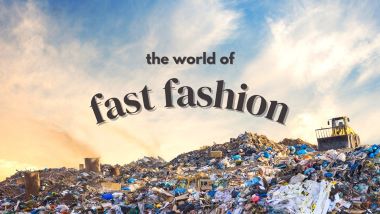Have you ever felt that little rush of adrenaline when you find a t-shirt for the price of a cup of coffee? It's a tempting feeling. In a world where trends change at the speed of a click, fast fashion offers us the instant gratification of wearing something new without even noticing it in your pocket. But have you ever stopped to think about the real price of that bargain?
When a garment has a ridiculously low price, it's not by magic. The answer, although inconvenient, is simple and rests on three invisible pillars:
. Low-quality materials: Cheap synthetic fibers that are produced quickly and degrade even faster.
. Manufacturing in low-cost countries: A euphemism to describe places where labor is extremely cheap.
. Externalized costs: The expense the company saves on workplace safety and environmental protection, a "saving" that we all pay for as a society and on the planet.
As consumers, we don't see the precarious factories or the polluted rivers. And as the saying goes, "out of sight, out of mind." We try on the garment, pay, and go home, unwittingly participating in a cycle with devastating consequences.
This is where the story gets really stark, as a powerful article I read in The Guardian recounted. When we get rid of unwanted clothes, we often think they'll go to a secondhand store or be recycled cleanly. The reality is very different. Much of the textile waste from the West embarks on a long journey to countries like India.

A large portion of this clothing travels to Panipat, a region north of Delhi sadly known as the "textile waste capital of the world." Every year, nearly one million tons of used clothing arrive here. Some 20,000 companies and nearly 400,000 workers are dedicated to "recycling" it.
The conditions are appalling. Workers, many of them women and children, tear apart fabrics by hand in unventilated warehouses, exposed to toxic dust from fibers, dyes, and chemicals. Respiratory and skin diseases are commonplace. People work there because there simply isn't a better alternative. It's a choice between exploitation or hunger.
The process taking place in Panipat isn't recycling in the purest sense. It's "downcycling." Fibers from different garments are mixed and shredded to create a very low-quality, weak, and brittle yarn. This material is used to make low-cost blankets or other cheap garments that will only last a few uses before being discarded again.
So we're faced with a key question: is this system a consequence of fast fashion or its origin? The answer is both. It's a vicious cycle. The demand for cheap clothing in our countries fuels this global throwaway industry, and this industry's ability to produce low-cost threads keeps the "junk clothing" cycle turning.
The good news is that, as consumers, we have more power than we think. It's not about feeling guilty, but about being aware. Every purchase is a vote. Extending the life of our clothes, buying secondhand, opting for quality over quantity, and supporting brands that are transparent about their production chains are small gestures with a giant impact.
The next time you see an incredible sale, remember the invisible thread that connects that garment to places like Panipat. Maybe, just maybe, you'll decide that true luxury isn't new clothes every week, but rather having a wardrobe that respects both people and the planet.
The decision is yours.